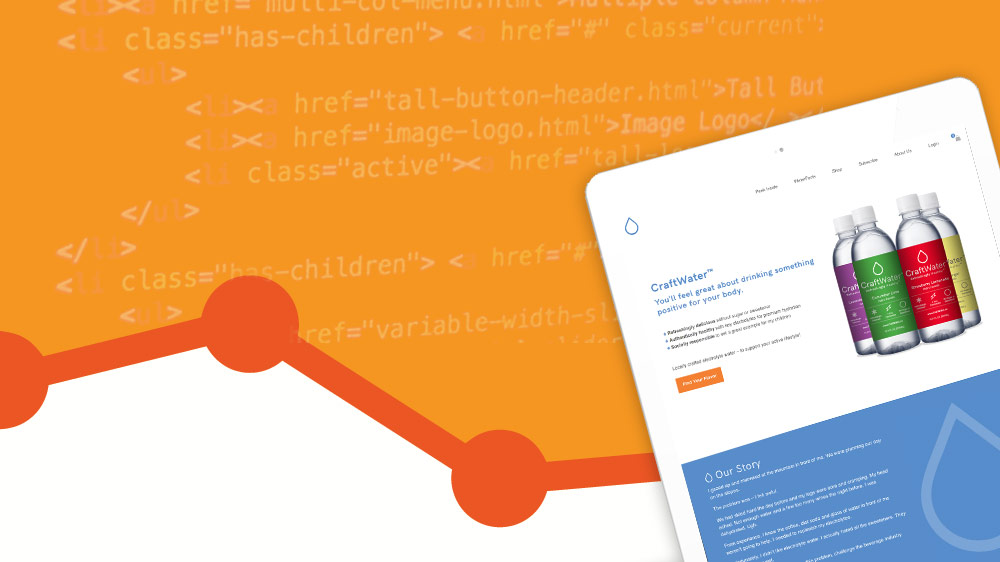Data driven design is the latest buzzword, especially in the context of data driven website design. As analytics become more accessible, more and more businesses are asking for all decisions to be backed by data, and that includes switching gears from what is pretty to what is functional.
We work with a lot of small businesses and startups who want a data-driven approach, and we typically say “no problem!”. However, the ability to make informed decisions is dependent on the quantity & quality of data available. Read on to learn more about how the For You Design team approaches data driven website design, both before & after the website launch.
BEFORE Website Design – If you have data
Ideally, you have an existing site with some analytics tool already installed. If you never installed Google Analytics, take a look through your platform provider to see if they have anything out of the box. Sites like GoDaddy and 1&1 have a light version of analytics included.
If you do have some data, we’ll take a look at the basics at a minimum to inform the design of your site:
- Top pages viewed & potentially the path between them
- Overall volume, broken down by mobile
- Conversion metrics, perhaps including bounce/exit rates
- Profile of a “converter”; what do we know about people filling out the lead form or making purchases?
All of these are clues to the site structure, level of content, and even the aesthetics that are likely to drive the ideal actions on your site.
BEFORE Website Design – If you don’t have data
Many, many clients don’t have anything for us to start with because they are either startups or because they never installed an analytics tool. In these cases, we have a few options for approach:
- Our experience: We have been fortunate to work with clients across several industries, sizes, and business models. As a result, we have some informal “data” that we can apply to your situation. We can apply specialized insights from similar clients and bring fresh ideas from those that are different.
- Your experience: It is more helpful than it seems when a client, even one who is just starting out, can tell us about their customers. One of our startup clients was selling at Farmer’s Markets, and she was able to describe the profile of a typical customer, why they buy, and which messages are most likely to resonate with that person – all because she took a few minutes during each sale to ask questions. Although it’s not scientific, we can take this “data” and translate it into a design.
- Google & third party tools: People who collect data at a large scale sometimes share it for free. We know a lot of the best practices, but we can find more industry-specific insights through these tools. For example, Google’s Keyword Planner can reveal important keywords and influence the structure of the site.
The point is that the design still isn’t created in a vacuum of what is pretty; the data is not as specific, scientific, or formal, but it still informs the website design & decision making process.
AFTER Website Launch – Let’s gather some data! (& maybe optimize)
So, we were able to provide data driven website design. Now you have a website that is live for all to use. This is the most important part of the For You Design services: we provide a custom Google Analytics installation with every website. This includes (at a minimum):
- Goal setup
- Custom event tracking
- Integration with marketing tools
We also often continue the relationship with our clients after launch by providing a 30-day website analysis with insights. It’s a deep dive into the behavior & profiles of people on your site, which often reveals opportunities to improve the site content, the design, or the marketing. We pair your data with benchmarks to provide some context as well.
The Bottom Line for Data Driven Website Design
If you’re in the market for a new website and you haven’t considered the merits of data-driven website design, get on board now. It not only makes logical sense, but also will result in a higher ROI by either saving you in design & development costs or resulting in higher revenue (or both!). Plus, all the largest companies are investing heavily in data, and with the explosion of tools available, there’s no excuse for the smaller ones not to join the party.
Tell us what your project is, and we’ll give you some more specific detail on how we would approach it from a data-driven design perspective.
